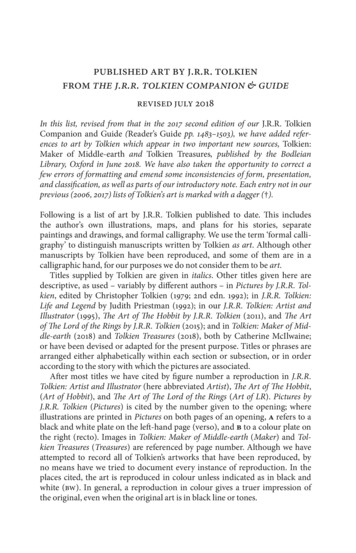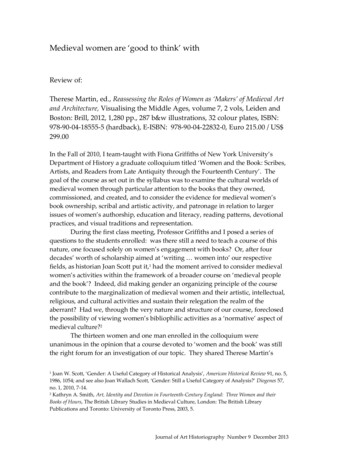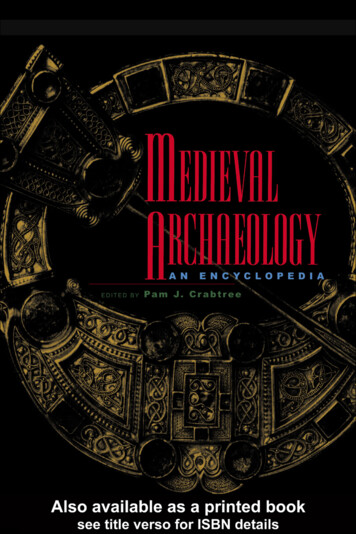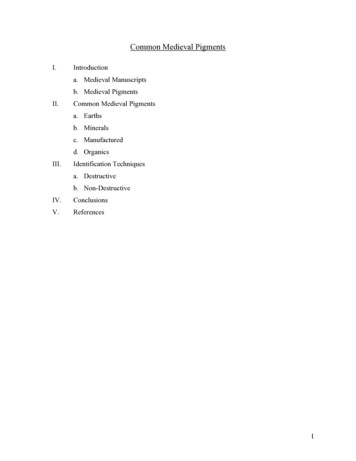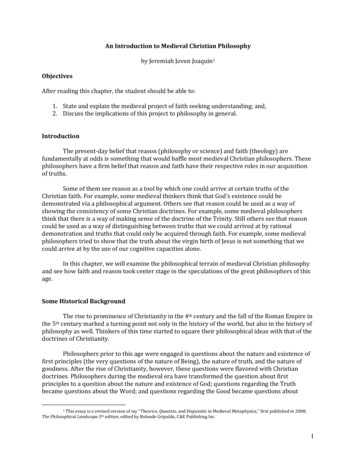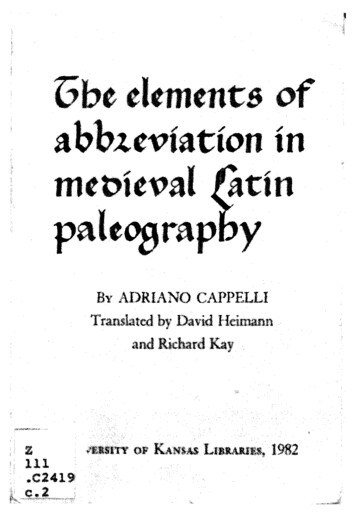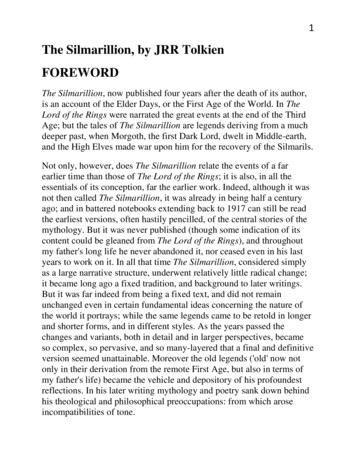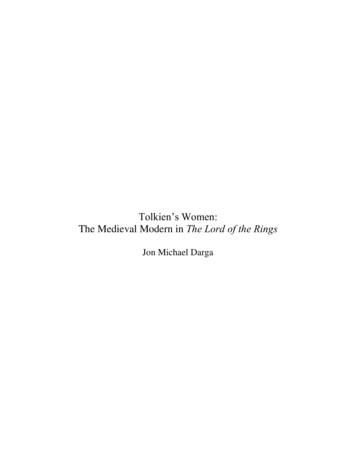
Transcription
Tolkien’s Women:The Medieval Modern in The Lord of the RingsJon Michael Darga
Tolkien’s Women:The Medieval Modern in The Lord of the RingsbyJon Michael DargaA thesis presented for the B.A. degreewith Honors inThe Department of EnglishUniversity of Michigan
Winter 2014
2014 Jon Michael Darga
For my cohort, for the support and for the laughter
AcknowledgementsMy thanks go, first and foremost, to my advisor Andrea Zemgulys. She took a riskagreeing to work with a student she had never met on a book she had no academic experience in,and in doing so she gave me the opportunity of my undergraduate career. Andrea knew exactlywhen to provide her input and when it was best to prod and encourage me and then step out ofthe way; yet she was always there if I needed her, and every book that she recommended openedup a significant new argument that changed my thesis for the better. The independence andguidance she gave me has resulted in a project I am so, so proud of, and so grateful to her for. Ifeel so lucky to have had an advisor who could make me laugh while telling me how badly mythesis needed work, who didn’t judge me when I came to her sleep-deprived or couldn’t expressmyself, and who shared my passion through her willingness to join and guide me on this ride.Her constant encouragement kept me going.I also owe a distinct debt of gratitude to Gillian White, who led my cohort during the fallsemester. Gillian has a distinct aptitude for providing tough love, and asking exactly the rightquestions, then sitting back and letting you discover the answers. My thesis began as a broadattempt to prove a general claim about Tolkien and women, and has become something muchricher and more rewarding thanks to her guidance. Gillian’s incisive comments made me feelconfident entering the second semester, which was an immense gift.Catherine Sanok, Jennifer Wenzel, and Hilary Wolkan are also much deserving of thanks.Professor Sanok lent me her knowledge and her books when I came to her asking for advice onlyric poems and anchoresses without knowing exactly what I wanted to do with them. The advicethat she gave me in her office hours has been in every draft since. Though I didn’t get to work
with Jennifer as closely as others, her constant support and check-ins to keep me on task havebeen very appreciated. And Hilary not only welcomed the opportunity to read my thesis, sheinsisted on doing it twice, with incisive and useful comments both times. I appreciate all of yourhelp so much.I would like to thank the family and friends that supported me throughout this process –there are too many to name individually, but their interest and offers of help all mean a greatdeal. I also need to give a special thank you to my thesis cohort, specifically those who werealways on hand to offer me support, or the opportunity to de-stress, or who listened patiently as Igeeked out over all things related to Middle-earth: Andy, Eleanor, Emma, Jacqueline, Pierre, andZilli. You made this experience more than rewarding, and you made it fun.Finally, I owe a debt to both Peter Jackson and J.R.R. Tolkien for this thesis. The former,for creating the movies that introduced me to Middle-earth as a fifth-grader; the latter, foreverything that has gone into these pages. Professor Tolkien created a work that I never tired of,regardless of how many sleepless nights I spent surrounded by scribbled notes and visions ofhobbits. I feel lucky to have been able to work with a book that I am so passionate about and findso inspiring, and to know so much more about the man behind it than I did a year ago.Thank you.
AbstractThe women of The Lord of the Rings may appear, at first glance, to play only abackground role in the text’s narrative structure. However, their significance extends far beyondmerely affecting the plot. There is a clear alignment between Tolkien’s real-life views and thequalities represented by his women characters, whom he draws attention to by depicting aspowerful and wise. What, then, does he hope to showcase by setting these women apart asdistinct, both within his world and that of Middle-earth?By his own admission, Tolkien was greatly influenced by the arts and crafts movement ofthe late 19th-century, which sought to provide a greater cultural emphasis on all forms of artistryand nature, and a reduced emphasis on mechanized industry. Although this movement ended atthe beginning of the 20th-century, branches of it continued, arguing that the correct sense ofartistry and spirituality could be found by looking back to medieval England, and that thesequalities could be used to help heal the modern ravaged and industrialized country. I posit thatTolkien drew attention to his female characters to link them with his use of this movement, inorder to exemplify the idealized qualities that he feels can repair a nation.There are three powerful, ageless women in Rings: Arwen the Elf princess, Goldberry theriver-sprite, and Galadriel the Lady of the Golden Wood. Each of them represents a differentfacet that Tolkien idealized as a part of his use of the medievalized movements, and each of theminspire and positively influence the main male characters in a way that helps them rid Middleearth of evil. Arwen, who stays at home while her husband claims his right as king, spends hertime weaving a tapestry, evoking frequent comparisons to her ancestor Lúthien, an Elf whoexpressed her unusual power through song and dance. Through these two, Tolkien exemplifiesthe healing power in arts and crafts, as well as the significance in looking back and takinglessons and cues from history. Goldberry expands upon this power; she represents all thingsartful and pure in nature, and displays the purity and wholesomeness in both protecting natureand allowing it to influence one’s daily life. In Galadriel, Tolkien chooses to focus on thespiritual aspect of medievalized ideals, drawing distinct comparisons to medieval anchoritehermits and their emphasis on confronting temptation.There are still two significant females left in Rings, though neither fit exactly with theothers: Shelob the spider and Éowyn the human shieldmaiden. Tolkien uses these two toexemplify the same principles as Arwen, Goldberry, and Galadriel, but in different ways. InShelob, a gluttonous and evil monster, he displays how one can lose their humanity if the arts,nature, and religion are ignored; in Éowyn, he showcases how a “modern day” woman can applyhis medievalized qualities to a nation at war. Viewed as a collective, the females of Rings aremeant to represent how Tolkien’s interpretations of medieval principles can be used to healEngland in the wake of the World Wars.
iiCONTENTSShort Titles.iiIntroduction.1I. Arwen and Lúthien – The Figures of Art.10II.Goldberry – The Figure ofNature.26III.Galadriel – The Figure ofReligion.37IV.Éowyn – The Figure ofModernity.52Conclusion.65Works Consulted.68
Short TitlesLetters: Tolkien, J.R.R. The Letters of J.R.R. Tolkien. ed. Humphrey Carpenter and ChristopherTolkien. Boston: Houghton Mifflin Company, 1981. Print.Rings: Tolkien, J.R.R. The Lord of the Rings. Boston: Houghton Mifflin Company, 2004. Print.
1INTRODUCTION“I propose to speak about fairy-stories, though I am aware that this is a rash adventure.”1So begins J.R.R. Tolkien’s 1939 essay “On Fairy-Stories,” in which he asserts the importance offairy tales in modern culture. Critically reading Tolkien’s crowning work, The Lord of the Rings,is no less of a rash adventure: though he was prone to handwriting answers pages long inresponse to questions readers would write in and ask, he was noticeably cagey regarding anyactual literary analysis of his works, responding to a student’s queries on hobbits in a 1938 letterby asking, “Would not that be rather unfair to the research students? To save them the trouble [ofanalysis] is to rob them of any excuse for existing.”2 Caginess became outright refusal whenRings earned a second edition printing; in his foreword, Tolkien warned that “as for any innermeaning or ‘message’, it has in the intention of the author none. It is neither allegorical nortopical.”3Attempting to prove Tolkien wrong about his own intentions is, perhaps, too much of arash adventure for any critic. However, while he remained steadfast until his death that there isno hidden meaning to the journey of the Ring, he admitted that he was, as all writers are,influenced by contemporary events.4 No doubt the message behind “Fairy-Stories,” that thelessons to be gleaned from fairy tales are perhaps more important for adults than children, wasalso very much in Tolkien’s mind when writing Rings. Rings does, in fact, fit entirely hisdescription of such a story: “[Stories about] Faërie contain many things besides elves and fays,and besides dwarfs, witches, trolls, giants, or dragons: it holds the seas, the sun, the moon, thesky; and the earth, and all things that are in it: tree and bird, water and stone, wine and bread, and1J.R.R. Tolkien, “On Fairy-Stories,” The Tolkien Reader, New York: Ballantine Books, 1966, 33, Print.J.R.R. Tolkien, The Letters of J.R.R. Tolkien, ed. Humphrey Carpenter and Christopher Tolkien, Boston: HoughtonMifflin Company, 1981, 30, Print.3J.R.R. Tolkien, The Lord of the Rings, Boston: Houghton Mifflin Company, 2004, xxiii, Print.4Ibid.2
2ourselves, mortal men, when we are enchanted.”5 His definition is purposefully broad. All that afairy tale needs to be classified as such is to “enchant” the reader to the story. If, then, Rings is afairy tale, Tolkien himself acknowledges through his essay that, despite his protests, there is aninherent application and meaning for his novels in modern culture: in the case of Rings, anEngland ravaged by the World Wars.That application is to demonstrate the importance and power of arts and crafts, nature,and religion in a war-torn nation, and it is represented by three of Rings’ female characters:Arwen the Elven princess of Rivendell, Goldberry the river sprite, and Galadriel the Elf-queen. Itis clear, at least within Rings’ narrative, that these three are meant to draw the reader’s attentionas timeless characters who also exhibit the greatest displays of power; I will use “timeless” torefer to a sense of immortal agelessness, as well as an historical aura that compels othercharacters, and therefore the reader, to reflect back to earlier times upon encountering thesewomen. More specifically, they hearken back to the ideal glory days of the past where peace andpurity reigned in the earlier ages of Middle-earth, echoing Tolkien’s own obsessive nostalgia fora medieval past.6 Additionally, Tolkien gives each of them reserves of magical power thatelevates them above their companions and counterparts. (As will be thoroughly explained in alater section, the character Arwen is viewed as one with her ancestor Lúthien, who fits thesedescriptions more immediately.) Only the Maiar, Middle-earth’s angels – Gandalf, TomBombadil, Saruman, and Sauron – exhibit more power, and all are viewed by the characters andTolkien himself as quite literally God-like (or, in Sauron and Saruman’s cases, Satanic) figures.75Tolkien, “On Fairy-Stories,” 38.Christopher Snyder, The Making of Middle-earth: A New Look Inside the World of J.R.R. Tolkien, New York:Sterling, 2013, 33, Print.7Tolkien, Letters, 191-192.J.R.R. Tolkien, The Silmarillion, ed. Christopher Tolkien, Boston: Houghton Mifflin Company, 1999, Print.6
3The reason that Tolkien meant to draw attention to these women and their timelessness isperhaps best explained by the trend of medieval modernism, which swept England at the sametime that Rings was written. Historian Michael T. Saler describes the movement:.[it] Reiterated conceptions of art and society found in the writings of.nineteenth-century romantic medievalists. These writers contrasted the modernindustrial world to the spiritual, communal, and harmonious world thatsupposedly existed in ages preceding the Renaissance. They looked backnostalgically to a time when art was simply ‘right-making,’ when common itemsno less than paintings and statues were created with devotion and valued asexpressions of the divine spirit, when the everyday was emblematic of a universalorder, when all was a divine creation.8I propose that Tolkien looked around himself, saw a war-torn nation, and decided to “makeright.” As an Old English historian, a fantasy writer, and a former soldier with a noted hatred ofindustrialism and war, he was in the perfect position to use both this movement and his ownpersonal beliefs. Writing was, to him, a way of healing himself and making sense of the worldaround him.9 Arwen, Goldberry, and Galadriel are the representations of this medieval modern inRings, each representing a different facet of an idealized past that Tolkien believed wasimportant to revive in order to correct England.Medieval modernism is also key to understanding why Tolkien chose to use women asthe representatives of his beliefs, though it is important here to note that the following statementsare not meant to accurately represent the life of English women, but rather how they wereenvisioned and idealized by Tolkien. Written almost exclusively during a period of war, Ringsfor the most part – the exception to this rule, Éowyn, will be discussed at length in her ownchapter – aligns with convention: men are the soldiers fighting bravely for their country, andwomen remain behind, busying themselves with matters of peaceful importance on the home8Michael T. Saler, The Avant-Garde in Interwar England: Medieval Modernism and the London Underground,New York: Oxford University Press, 1999, 18, Print.9John Garth, Tolkien and the Great War: The Threshold of Middle-earth, Boston: Houghton Mifflin Company,2003, Print.
4front. As an advocate of peace, Tolkien saw women as fulfilling a role that men simply couldnot, spiritually revitalizing English culture as religious and artistic figures. However, whenWorld War II dominated the landscape, the jobs of women became increasingly combat-relatedas they began filling the roles of industrial workers, producing wartime armaments andsupplies.10With modern-day women no longer able to represent this idealized spirit of peacetime,Tolkien turned to the medieval, where females remained focused on things such as arts andcrafts, and religion, even in times of war. Medieval women were wartime figures corrective ofwar, not occupied by battle but by wholesomeness and cultural healing. Thus, Tolkien makes thewomen in Rings historical and timeless, and gives them a unique strength with which to respondto the destructions of war. It should be noted here, as well, that Tolkien placing a more peacefulemphasis on women is not mean to imply that he did not believe that women were capable of orshould be involved actively in wartime. Rather, he felt that nobody should be involved in war,and that women, historically represented as figures removed from battle, were the best way toexemplify his view.This explains, then, why Arwen, Goldberry, and Galadriel, despite being key figureswithin the world of Middle-earth, do not play crucial roles within the narrative itself; all of themremain behind while other groups push forward and actively engage the enemy. We might ask:what would make these women stand out to anybody but Tolkien? He solved this potentialproblem by making his depiction of women distinct within the expectations of the time period.As he wrote the majority of Rings in-between the World Wars, women were still predominantlycaretakers or unpaid semi-professionals; societal roles were still defined by conservative10Ross McKibbin, Classes and Cultures: England 1918-1951, New York: Oxford University Press, 1998, Print.
5opinions and practices.11 By marking Arwen, Goldberry, Galadriel, and Éowyn as powerful andwise, in many cases more so than Rings’ men, Tolkien distinguishes them from his averagemodern English woman. Furthermore, his depictions of women differed in power andprominence from all of his own previous work and those of his contemporaries, specifically hisclose writing friends C.S. Lewis and Charles Williams, whom historians Candice Fredrick andSam McBride describe as sexist and “perhaps gynophobic (fearing women), or possibly evenmisogynist (hating women),” respectively.12 Tolkien, meanwhile, though not a feminist by anymeans, was still relatively progressive and open-minded, even taking cues, as will be discussedin the Éowyn chapter, from the suffrage movement.From this point, we can locate the three distinct elements (which I will also refer to aspillars), as represented by the three distinct female characters, of the medieval modern thatTolkien hopes to bring to light and illuminate for his readers through fairy story: the importanceof arts and crafts, of nature, and of a medievalized concept of religion. In Chapter 1, I will beginby analyzing Arwen and her predecessor Lúthien. Arwen is only present in a handful ofpassages, but she makes her mark, staying behind in Rivendell to weave her betrothed Aragorn atapestry that, Tolkien suggests, turns the tide of the war. As was implied by Michael T. Salerearlier in this introduction, the arts and crafts movement of the late 19th-century was afundamental aspect of medieval modernism and a significant influence for Tolkien. Thisinfluence is visualized in Arwen, a singer and weaver, who accentuates the importance of stories(an echo of Tolkien’s “On Fairy-Stories”) and the role of the storyteller during wartime. Herancestor Lúthien and Lúthien’s beloved Beren, whose stories are detailed in The Silmarillion, a11Ibid.Sonya O. Rose, Which People’s War?: National Identity and Citizenship in Britain 1939-1945, Oxford: OxfordUniversity Press, 2003, Print.12Candice Fredrick and Sam McBride, Women Among the Inklings: Gender, C.S. Lewis, J.R.R. Tolkien, andCharles Williams, Westport, CT: Greenwood Press, 2001, 33, 35, Print.
6text that Tolkien intended his audience to read before Rings, is meant to be a direct parallel toArwen and Aragorn in Rings. Lúthien, also intensely powerful, uses the power of her songs toget her happy ending, and her story is invoked by both Arwen and Aragorn throughout Rings,Tolkien’s call to understand and appreciate the story of the past. I will also, in the first chapter,introduce the comparison method of Shelob the spider, who I will continue to revisit throughoutthe second and third chapters. Distinctly represented as a timeless and powerful female characterjust like the rest, Shelob exists in the story as a female monster and grotesquerie, used as anexample of the perversions of his pillars and how they can be used incorrectly.In Chapter 2, I will dissect the character of Goldberry, the river-daughter. First appearingin a poem pre-dating Rings as a river sprite seduced by the spirit of the Oxfordshire countryside,Goldberry represents Tolkien’s sense of nationality by specifically embodying the Thames river,the lifeblood of England. Not only does Goldberry never acknowledge the darkness thatthreatens to encompass Middle-earth, she does not fear it, instead expressing her gaiety andpower through song and tending the hearth.Chapter 3 will examine the figure of Lady Galadriel as Tolkien’s concept of idealizedmedieval religion. Although religion was incredibly important to soldiers and those at homeduring the World Wars, the modern Roman Catholic church, of which Tolkien was a staunchmember, was much diluted from the strength and some of the values that it possessed inmedieval England. This is not meant, on my part, to imply that Tolkien desired a return of thechurch’s full strength, i.e. burning heretics, but rather to emphasize the strong link betweenGaladriel and medieval anchoress nuns, and to show how anchoritic acknowledgement oftemptation and sin informs the character.
7Finally, in Chapter 4, I will discuss the character of Éowyn as Tolkien’s method ofapplying his pillars to a more “modern-day” woman. Though Éowyn, a shieldmaiden of Rohan,is neither timeless nor magically powerful, she is the most significant female in Rings; shedisguises herself as a man and rides to war, where she slays the enemy commander and, it isimplied, enables the forces of good to win. Though the medievalized lessons set down by Arwen,Goldberry, and Galadriel are not a direct fit to Tolkien’s modern day, here he adapts them to anation at war, placing increased importance on particular pillars and acknowledging others’insignificance until after the threat of the enemy has vanished.It should be noted that none of the “pillar figures” are human – Galadriel and Arwen areelves, while Goldberry is altogether undefined but is generally considered within the text someform of greater spirit – yet they are used to represent and discuss issues directly relating tohumanity. It is important, in this instance, to appreciate the significance that Tolkien placed onnonhuman creatures as representatives of humanity. Frodo and Sam, who could be consideredthe main characters, are, for example, hobbits, yet they embody Tolkien’s key ideals of findingbravery within oneself: “They are made small. partly to exhibit the pettiness of man. andmostly to show up, in creatures of very small physical power, the amazing and unexpectedheroism of ordinary men ‘at a pinch’.”13 Thus, in keeping with Tolkien’s ideology, I treat elvesand sprites not as nonhuman entities but as vessels through with the “amazing and unexpected”qualities of ordinary human beings can be displayed. I also wish to note that variouscapitalizations of the races throughout this thesis – i.e. Elf and elven – are not errors, but ratherdeferential to how Tolkien himself capitalizes throughout his work.In his female characters, Tolkien saw no less than a hope for the future of his country. Ido not mean to tout him as a feminist, or to engage with his real-world views of women; that13Tolkien, Letters, 158.
8argument has very little place in the following pages and has, indeed, been carried on by others. 14His fascination with the medieval modern as a larger movement, however, has not been touchedupon by the critical field. Tolkien saw his female characters as representatives of somethingsignificant; a simpler time and gentler qualities. One need only look at the scenes that take placein Minas Tirith’s Houses of Healing to see this. Tolkien makes sure to indicate that healing is adistinctly feminine quality before Gandalf states that “the hands of the king are the hands of ahealer, and so shall the rightful king be known.”15 Aragorn is that king, though he refuses to takehis title until Middle-earth sees peace. By healing the wounded, he makes his first realdeclaration of kingship. It would be possible to read this scene solely as Aragorn fulfilling thosekingly duties; a good king should, after all, heal his friends. However, through the reading that Isuggest, Aragorn is no longer just a king but a man appreciating the significant power of thefeminine and in his own acts of femininity, an understanding that has powerful impactthroughout the rest of the book and with its place in the real world. New meanings in the textbecome evident through placing an emphasis on the medieval, the influences of the arts andcrafts movement and, most of all, the strength of women.14Brenda Partridge, “No Sex, Please – We’re Hobbits: The Construction of Sexuality in The Lord of the Rings,”J.R.R. Tolkien: This Far Land, ed. Robert Giddings, New Jersey: Barnes & Noble Press, 1983, Print.15Tolkien, Rings, 862.
109I. ARWEN AND LÚTHIEN – THE FIGURES OF ARTThe character of Arwen is one of Rings’ greatest conundrums. The descendant ofLúthien, an Elf who defied her father’s wishes to rescue her imprisoned lover Beren from thevillainous Morgoth, Arwen spends the entire narrative in Rivendell obeying her father’s wishesand waiting for her betrothed to come home. Aside from their bloodlines, she and Lúthien appearat first glance to be two distinct and unrelated women, yet Tolkien clearly intends for his readersto make a comparison between the two: upon entering Rivendell, Frodo glimpses Arwen, “inwhom it was said that the likeness of Lúthien had come on earth again.”16 And, though the fullstory of Arwen and Aragorn is only told in Rings’ appendices, the background material thatTolkien’s publishers forced him to cut, it is a near-identical retelling of the tale of Lúthien andBeren. In fact, Aragorn is singing the lay of Lúthien as he comes across Arwen dancing in theforest, like Lúthien was doing when Beren first saw her, and mistakes Arwen for a resurrectedLúthien of the present-day. Furthermore, Arwen’s father Elrond, like Lúthien’s father Thingol,defers when Aragorn asks for her hand, stating that he, like Beren, must prove himself before thetwo can marry.17Rather than defy her father’s wishes and join her lover in his journey as Lúthien did,however, Arwen obeys and is summarily removed from the narrative. As such, many see Arwenas “Lúthien-lite,” a weakened and diluted version of her powerful ancestor.18 It is important,though, to note exactly what Arwen does while remaining in Rivendell: she weaves a tapestryproclaiming Aragorn’s rite as king, her own interpretation of Lúthien’s artistry. (As will be16Ibid. 227.Ibid. 1057-1063.18Faye Ringel, “Women Fantasists: In the Shadow of the Ring,” J.R.R. Tolkien and His Literary Resonances: Viewsof Middle-earth, ed. George Clark and Daniel Timmons, Greenwood, CT: Greenwood Press, 2000, 159-171, Print.17
11discussed later, all of Lúthien’s power derived from her artistic ability: singing, storytelling,dancing, and weaving.) It is exactly this that Tolkien hopes to emphasize through these twocharacters: the power and potency of the arts. Arwen is not as present in the story as herpredecessor, but her artistic skills are no less potent; her banner makes a statement so strong thatit convinces the army of the Dead of Aragorn’s heritage even though “it was black, and if therewas any device upon it, it was hidden in darkness.”19 Its powers are even greater when visible:A great standard broke, and the wind displayed it as she turned towards theHarlond. the stars flamed in the sunlight, for they were wrought of gems byArwen daughter of Elrond; and the crown was bright in the morning, for it waswrought of mithril and gold. and the mirth of the Rohirrim was a torrent oflaughter and a flashing of swords, and the joy and wonder of the City was a musicof trumpets and a ringing of bells. But the hosts of Mordor were seized withbewilderment. and a black dread fell on them, knowing that the tides of fate hadturned against them and their doom was at hand.20The mere unfurling of Arwen’s banner is enough to strike hope into two allied armies andforetell the doom of the enemy. Tolkien’s language similarly plays up themes of artistry,describing the celebration of Gondor as a “music of trumpets and a ringing of bells” anddepicting the Rohirrim’s increased slaughter (he explains, earlier in the battle narrative, thatRohirrim sing as they kill).21 Lúthien may have rescued and healed Beren with her art, butArwen changes the course of a battle and, ultimately, the fate of Middle-earth.This may seem a drastic overemphasizing of the power of artistry, which is exactlyTolkien’s intent, though to his mind it is not an overemphasis at all. Instead, he is heightening theideals of the 19th-century English arts and crafts movement, which pushed for a return to theideals of the Middle Ages, a greater emphasis on craftsmanship, and a reduced focus on19Tolkien, Rings, 789.Ibid. 847-848.21Ibid. 838.20
12industry.22 It is well established that Tolkien was heavily influenced by the movement – in a1960 letter he admits that pieces of Rings “owe more to William Morris,” the leader of the fad,than anything else – so it stands to reason that the arts would be well-represented as a part of hislooking back to medieval ideals.23 Morris, too, was unafraid of making massive claims regardingcraftsmanship, saying in his speech “Art and its Producers” that:[In] work so [artfully] done there is and must be the interchange of interest in theoccupations of life; the knowledge of human necessities & the consciousness ofhuman good-will is a part of all such work, and the world is linked together by it.The peace of the arts springs from its roots, and flourishes even in the midst ofwar and trouble and confusion.24The power of arts, then, is to Morris and the movement as a whole no less a thing than a forcewhich can bring about peace and withstand war. Tolkien introduces his own version of theseclaims to his readers in the form of Arwen and Lúthien.It is, perhaps, not surprising that many scholars do not agree with this interpretation ofart’s significance. Although it is Arwen’s craftsmanship that heralds that the tide of the battle hasturned, it does not, some argue, change the fact that she is trapped in a passive role during thetrilogy, thereby negating any emphasis Tolkien may be placing on her
The Lord of the Rings. Boston: Houghton Mifflin Company, 2004. Print. INTRODUCTION "I propose to speak about fairy-stories, though I am aware that this is a rash adventure."1, So begins J.R.R. Tolkien's 1939 essay "On Fairy-Stories," in which he asserts the importance of fairy tales in modern culture.


